Maintaining Those Pearly Whites
© 2005 Chey Miller
 In the dim, dark days of dog ownership, back when I was growing up in the '50s, our dogs ran free and lived on table scraps and Kennel Ration. The more enlightened dog owners took their dog to the vet for his rabies and distemper boosters, and some even had him "fixed". All things considered, Spot had a pretty good life.
In the dim, dark days of dog ownership, back when I was growing up in the '50s, our dogs ran free and lived on table scraps and Kennel Ration. The more enlightened dog owners took their dog to the vet for his rabies and distemper boosters, and some even had him "fixed". All things considered, Spot had a pretty good life.
His life might have been a little longer and more enjoyable if his owners had been more aware of Spot's dental health. Fifty or sixty years ago we were just figuring out that humans didn't have to lose teeth to decay in middle age. No surprise, then, that preventive oral hygiene wasn't stressed for man's best friend! But, even today, many people expect their dog to have abominable breath and lose a few teeth as they age. "He's a dog. Of course his breath reeks, look at the stuff he eats!" "He's old, so you have to expect him to lose a few teeth."
But it's not "the stuff he eats" or normal aging that causes the trouble, it's the assault on his teeth and gums by bacteria, salivary proteins, and food debris, which form a substance called plaque. The plaque settles in the channel between the teeth and gums and causes irritation and swelling, i.e., gingivitis. Gingivitis is curable; periodontal disease is not. When pockets form beneath the gums, bacterial infection is able to enter the bloodstream directly. Those organs which receive the greatest blood flow --lungs, heart, liver, kidneys, and the brain -- can be damaged by the infection, effectively shortening the life of the dog. At the very least, if he lives long enough without attention to oral hygiene, the dog will experience pain, tissue damage and bone loss. It is the loss of bone that permits the teeth to fall out.
Obviously, just as with humans, the answer is to keep plaque to a minimum. We can do that by feeding a high quality kibble, providing safe chewables such as Greenies and knuckle bones, and brushing the dog's teeth daily with a toothpaste formulated especially for dogs. (Human toothpastes contain ingredients that should not be swallowed, so do not use Colgate on your dog!) Yet, even with this attention to good dental health, you may eventually notice that your dog's teeth are mottled with yellow/brown tartar, and your vet may advise prophylactic treatment.
Ruby Gets Her Teeth Cleaned
 That was precisely the case with Ruby, my 8-year-old Basenji. When my vet recommended a cleaning, I wanted to make sure, first of all, that he was aware that the Basenji metabolizes drugs differently than other breeds; sighthounds have a higher muscle to fat ratio, and a safe anaesthetic for a German Shepard or a Yorkie may not be safe for a Basenji. Specifically, barbiturates are contraindicated in sighthounds or dogs with little body fat. (I am not implying that my vet is ignorant! However, Basenjis are uncommon in my area and some vets have never seen or treated one and may not know or remember that it is a sighthound. Better safe than sorry! And luckily, my vet is very understanding...I hope!) If you decide to have your Basenji's teeth cleaned, be sure to mention that he should receive the same drugs as a Greyhound. Also, do not try to cut corners by eliminating pre-anaesthesia bloodwork. It is important to ensure there are no underlying liver or kidney issues that could create an emergency situation under anaesthesia. The liver and kidneys metabolize and excrete the sedatives; if they are compromised, the drugs remain in the system longer and sedation can be deeper and longer lasting. Even young animals can have poorly functioning organs and should have bloodwork done.
That was precisely the case with Ruby, my 8-year-old Basenji. When my vet recommended a cleaning, I wanted to make sure, first of all, that he was aware that the Basenji metabolizes drugs differently than other breeds; sighthounds have a higher muscle to fat ratio, and a safe anaesthetic for a German Shepard or a Yorkie may not be safe for a Basenji. Specifically, barbiturates are contraindicated in sighthounds or dogs with little body fat. (I am not implying that my vet is ignorant! However, Basenjis are uncommon in my area and some vets have never seen or treated one and may not know or remember that it is a sighthound. Better safe than sorry! And luckily, my vet is very understanding...I hope!) If you decide to have your Basenji's teeth cleaned, be sure to mention that he should receive the same drugs as a Greyhound. Also, do not try to cut corners by eliminating pre-anaesthesia bloodwork. It is important to ensure there are no underlying liver or kidney issues that could create an emergency situation under anaesthesia. The liver and kidneys metabolize and excrete the sedatives; if they are compromised, the drugs remain in the system longer and sedation can be deeper and longer lasting. Even young animals can have poorly functioning organs and should have bloodwork done.
Ruby was injected with Domitor to sedate her prior to entubation. It was unsettling, to say the least, to watch her practically melt into the examining table within a minute or so of the intramuscular injection. At this point, Dr. Murphy wrapped her in a towel (hypothermia is an issue when respiration is depressed) and carried her into the surgical room. Sarah, the veterinary technician, applied ophthalmic ointment to Ruby's eyes, explaining that her reflexive blink would be supressed for as long as she was sedated; the ointment would prevent her corneas from drying.
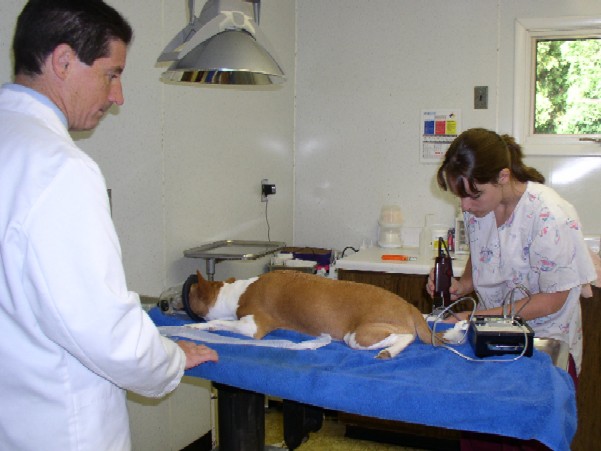 Isoflurane is one of the newest and safest inhalation anaesthetics in use, and is one of those recommended for sighthounds. (Sevoflurane is another.) Here, Ruby receives Isoflurane gas through a mask. While she is being inducted via mask, Sarah shaves a hind leg to create a good contact for the the blood pressure sensor that will be taped in place throughout the procedure.
Isoflurane is one of the newest and safest inhalation anaesthetics in use, and is one of those recommended for sighthounds. (Sevoflurane is another.) Here, Ruby receives Isoflurane gas through a mask. While she is being inducted via mask, Sarah shaves a hind leg to create a good contact for the the blood pressure sensor that will be taped in place throughout the procedure.
The depth of anaesthesia is monitored via the rate and quality of the pulse and heartbeat, body temperature, and color of mucous membranes. The inhalation of gas by the dog through the mask allows the vet to comfortably insert a tube into the dog's windpipe. The tube establishes an unobstructed airway that could be vital should complications arise.
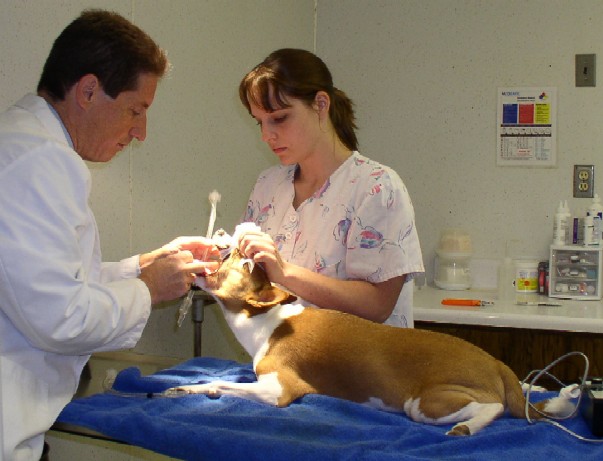 Now that she is sufficiently "under" Dr. Murphy prepares to insert the tube into the windpipe, while Sarah steadies Ruby's head. A long piece of gauze-like material will tie the endotracheal tube in place and prevent it being coughed out.
Now that she is sufficiently "under" Dr. Murphy prepares to insert the tube into the windpipe, while Sarah steadies Ruby's head. A long piece of gauze-like material will tie the endotracheal tube in place and prevent it being coughed out.
 Dr. Murphy shaves an area on one of the front legs for insertion of an intravenous catheter. Ruby will receive fluids during the procedure to keep her blood pressure up, and pain medication to smooth the recovery from the procedure. The catheter is also a gateway for emergency drugs such as epinephrine, sodium bicarbonate, or atropine, if needed.
Dr. Murphy shaves an area on one of the front legs for insertion of an intravenous catheter. Ruby will receive fluids during the procedure to keep her blood pressure up, and pain medication to smooth the recovery from the procedure. The catheter is also a gateway for emergency drugs such as epinephrine, sodium bicarbonate, or atropine, if needed.
Aside: Ruby leaked urine throughout the procedure. At one point, Dr. Murphy tilted the table downward and pressed her abdomen to empty her bladder. Since I made sure she peed before we arrived at the hospital, I was astonished at the volume, until I remembered that her tissues were being suffused with fluids through the IV drip.
As long as Ruby was anaesthetized, I decided to have her microchipped, as well. You can just see the spot near her right shoulder where Dr. Murphy shaved to insert the quarter-inch-long Home Again chip. That's another good thing to consider if your dog has to be anaesthetized for some reason.
 Ruby has moderate tartar, not bad for an 8-year-old, but those teeth definitely need some attention! Dr. Murphy points out that there are salivary glands embedded in the gums above the upper molars which constantly bathe the teeth with the proteins which, combined with food and bacteria, produce plaque.
Ruby has moderate tartar, not bad for an 8-year-old, but those teeth definitely need some attention! Dr. Murphy points out that there are salivary glands embedded in the gums above the upper molars which constantly bathe the teeth with the proteins which, combined with food and bacteria, produce plaque.
Note the slight irritation of the gums where they meet the teeth. This is gingivitis.
 Large areas of tartar, also known as calculus, are removed with a special tool. Removing large areas all at once shortens the duration of the anaesthesia. Ruby's jaws are held open with a spring retractor.
Large areas of tartar, also known as calculus, are removed with a special tool. Removing large areas all at once shortens the duration of the anaesthesia. Ruby's jaws are held open with a spring retractor.
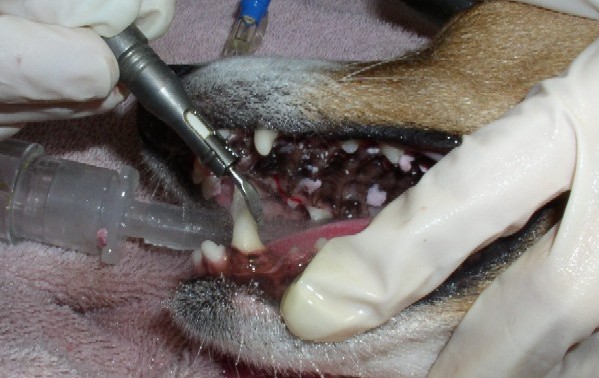 Once the large areas of tartar have been removed, Sarah uses a Cavitron ultrasonic scaler to remove smaller pieces of calculus. Despite emitting a continual fine mist of water, the tool creates friction on the tooth surface that can burn if left in place too long. Sarah makes sure the Cavitron is never on a tooth longer than four seconds. If necessary, she comes back to work on that tooth later. Ruby's teeth are looking good!
Once the large areas of tartar have been removed, Sarah uses a Cavitron ultrasonic scaler to remove smaller pieces of calculus. Despite emitting a continual fine mist of water, the tool creates friction on the tooth surface that can burn if left in place too long. Sarah makes sure the Cavitron is never on a tooth longer than four seconds. If necessary, she comes back to work on that tooth later. Ruby's teeth are looking good!
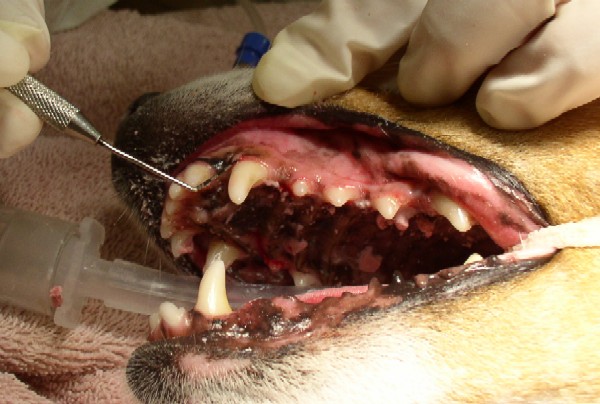 Sarah discovers very two shallow pockets beneath Ruby's gums, an early sign of gingival detachment. If this were ignored, it would progress to gum recession and periodontitis.
Sarah discovers very two shallow pockets beneath Ruby's gums, an early sign of gingival detachment. If this were ignored, it would progress to gum recession and periodontitis.
The gauging tool is marked in 5 millimeter increments. 2-3 millimeters is the "normal" measurement of depth of gumline. Ruby's will require no further treatment.
 No tooth cleaning would be complete without polishing! Sarah uses a compound called Zircon-F, which smooths the surface of the enamel and fills in any grooves made by the scaling tool. The polish smells like bubble gum.
No tooth cleaning would be complete without polishing! Sarah uses a compound called Zircon-F, which smooths the surface of the enamel and fills in any grooves made by the scaling tool. The polish smells like bubble gum.
The cleaning completed by Sarah, Dr. Murphy comes in to double check. Ruby's teeth get a clean bill, and Sarah applies a two-week coating of OraVet Gel, which should provide additional protection against plaque.
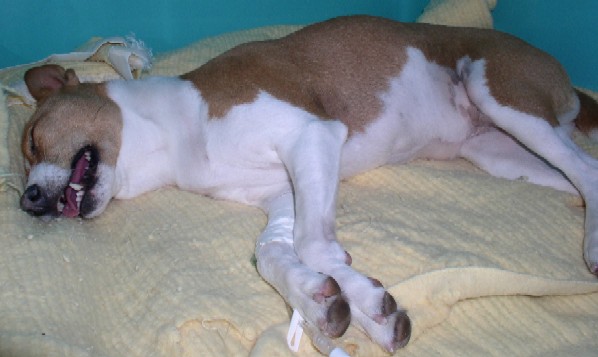 Dr. Murphy administers an injection of Antisedan, the reversal agent of Domitor, and carries Ruby to a cage in a darkened room. Within a couple of minutes, Ruby will awaken from the anaesthesia, but the IV catheter is left in place until she begins to stir, just in case there is trouble. Dr. Murphy watches very closely at this time. "If I lose a dog, I don't ever want it to be because I wasn't paying attention," he says. I appreciate his vigilance. The recovery period is the most critical time because there are often other distractions in a veterinary hospital and sometimes the dog is not faithfully monitored.
Dr. Murphy administers an injection of Antisedan, the reversal agent of Domitor, and carries Ruby to a cage in a darkened room. Within a couple of minutes, Ruby will awaken from the anaesthesia, but the IV catheter is left in place until she begins to stir, just in case there is trouble. Dr. Murphy watches very closely at this time. "If I lose a dog, I don't ever want it to be because I wasn't paying attention," he says. I appreciate his vigilance. The recovery period is the most critical time because there are often other distractions in a veterinary hospital and sometimes the dog is not faithfully monitored.
As Ruby begins to stir, Dr. Murphy removes the catheter and bandages the entry site. Because Domitor can cause agitation when the dog awakens, we move outside the room to reduce any stress. We watch through the window as she stands and moves about. Leaving Sarah in charge of Ruby's recovery, Dr. Murphy fixes me a cup of coffee while I wait for Ruby to regain her senses.
 An hour later, Ruby and I leave to come home. Under ordinary circumstances, she would have remained at the hospital to recover for the remainder of the afternoon. She was a bit unsteady and spent the most of the next six hours sleeping in her favorite chair. Apparently experiencing some discomfort, she moaned occasionally through the afternoon and early evening. However, by the time the dinner bell rang, she was feeling like herself again and was ready to put those gleaming white teeth to use!
An hour later, Ruby and I leave to come home. Under ordinary circumstances, she would have remained at the hospital to recover for the remainder of the afternoon. She was a bit unsteady and spent the most of the next six hours sleeping in her favorite chair. Apparently experiencing some discomfort, she moaned occasionally through the afternoon and early evening. However, by the time the dinner bell rang, she was feeling like herself again and was ready to put those gleaming white teeth to use!
My sincere thanks to Dr. William Murphy of Palmyra Animal Hospital, Palmyra, NY for allowing me to observe and photograph this procedure. Thanks also to veterinary technician Sarah Bott for her patient explanations and for holding a pose so I could get the shot I needed. Ruby thanks them for taking such good care of her!
Additional thanks to Linda Siekert, C.V.T., V.D.T., for checking this material for accuracy and for numerous helpful suggestions.
 In the dim, dark days of dog ownership, back when I was growing up in the '50s, our dogs ran free and lived on table scraps and Kennel Ration. The more enlightened dog owners took their dog to the vet for his rabies and distemper boosters, and some even had him "fixed". All things considered, Spot had a pretty good life.
In the dim, dark days of dog ownership, back when I was growing up in the '50s, our dogs ran free and lived on table scraps and Kennel Ration. The more enlightened dog owners took their dog to the vet for his rabies and distemper boosters, and some even had him "fixed". All things considered, Spot had a pretty good life. That was precisely the case with Ruby, my 8-year-old Basenji. When my vet recommended a cleaning, I wanted to make sure, first of all, that he was aware that the Basenji metabolizes drugs differently than other breeds; sighthounds have a higher muscle to fat ratio, and a safe anaesthetic for a German Shepard or a Yorkie may not be safe for a Basenji. Specifically, barbiturates are contraindicated in sighthounds or dogs with little body fat. (I am not implying that my vet is ignorant! However, Basenjis are uncommon in my area and some vets have never seen or treated one and may not know or remember that it is a sighthound. Better safe than sorry! And luckily, my vet is very understanding...I hope!) If you decide to have your Basenji's teeth cleaned, be sure to mention that he should receive the same drugs as a Greyhound. Also, do not try to cut corners by eliminating pre-anaesthesia bloodwork. It is important to ensure there are no underlying liver or kidney issues that could create an emergency situation under anaesthesia. The liver and kidneys metabolize and excrete the sedatives; if they are compromised, the drugs remain in the system longer and sedation can be deeper and longer lasting. Even young animals can have poorly functioning organs and should have bloodwork done.
That was precisely the case with Ruby, my 8-year-old Basenji. When my vet recommended a cleaning, I wanted to make sure, first of all, that he was aware that the Basenji metabolizes drugs differently than other breeds; sighthounds have a higher muscle to fat ratio, and a safe anaesthetic for a German Shepard or a Yorkie may not be safe for a Basenji. Specifically, barbiturates are contraindicated in sighthounds or dogs with little body fat. (I am not implying that my vet is ignorant! However, Basenjis are uncommon in my area and some vets have never seen or treated one and may not know or remember that it is a sighthound. Better safe than sorry! And luckily, my vet is very understanding...I hope!) If you decide to have your Basenji's teeth cleaned, be sure to mention that he should receive the same drugs as a Greyhound. Also, do not try to cut corners by eliminating pre-anaesthesia bloodwork. It is important to ensure there are no underlying liver or kidney issues that could create an emergency situation under anaesthesia. The liver and kidneys metabolize and excrete the sedatives; if they are compromised, the drugs remain in the system longer and sedation can be deeper and longer lasting. Even young animals can have poorly functioning organs and should have bloodwork done. Isoflurane is one of the newest and safest inhalation anaesthetics in use, and is one of those recommended for sighthounds. (Sevoflurane is another.) Here, Ruby receives Isoflurane gas through a mask. While she is being inducted via mask, Sarah shaves a hind leg to create a good contact for the the blood pressure sensor that will be taped in place throughout the procedure.
Isoflurane is one of the newest and safest inhalation anaesthetics in use, and is one of those recommended for sighthounds. (Sevoflurane is another.) Here, Ruby receives Isoflurane gas through a mask. While she is being inducted via mask, Sarah shaves a hind leg to create a good contact for the the blood pressure sensor that will be taped in place throughout the procedure.  Now that she is sufficiently "under" Dr. Murphy prepares to insert the tube into the windpipe, while Sarah steadies Ruby's head. A long piece of gauze-like material will tie the endotracheal tube in place and prevent it being coughed out.
Now that she is sufficiently "under" Dr. Murphy prepares to insert the tube into the windpipe, while Sarah steadies Ruby's head. A long piece of gauze-like material will tie the endotracheal tube in place and prevent it being coughed out. Dr. Murphy shaves an area on one of the front legs for insertion of an intravenous catheter. Ruby will receive fluids during the procedure to keep her blood pressure up, and pain medication to smooth the recovery from the procedure. The catheter is also a gateway for emergency drugs such as epinephrine, sodium bicarbonate, or atropine, if needed.
Dr. Murphy shaves an area on one of the front legs for insertion of an intravenous catheter. Ruby will receive fluids during the procedure to keep her blood pressure up, and pain medication to smooth the recovery from the procedure. The catheter is also a gateway for emergency drugs such as epinephrine, sodium bicarbonate, or atropine, if needed. Ruby has moderate tartar, not bad for an 8-year-old, but those teeth definitely need some attention! Dr. Murphy points out that there are salivary glands embedded in the gums above the upper molars which constantly bathe the teeth with the proteins which, combined with food and bacteria, produce plaque.
Ruby has moderate tartar, not bad for an 8-year-old, but those teeth definitely need some attention! Dr. Murphy points out that there are salivary glands embedded in the gums above the upper molars which constantly bathe the teeth with the proteins which, combined with food and bacteria, produce plaque.  Large areas of tartar, also known as calculus, are removed with a special tool. Removing large areas all at once shortens the duration of the anaesthesia. Ruby's jaws are held open with a spring retractor.
Large areas of tartar, also known as calculus, are removed with a special tool. Removing large areas all at once shortens the duration of the anaesthesia. Ruby's jaws are held open with a spring retractor. Once the large areas of tartar have been removed, Sarah uses a Cavitron ultrasonic scaler to remove smaller pieces of calculus. Despite emitting a continual fine mist of water, the tool creates friction on the tooth surface that can burn if left in place too long. Sarah makes sure the Cavitron is never on a tooth longer than four seconds. If necessary, she comes back to work on that tooth later. Ruby's teeth are looking good!
Once the large areas of tartar have been removed, Sarah uses a Cavitron ultrasonic scaler to remove smaller pieces of calculus. Despite emitting a continual fine mist of water, the tool creates friction on the tooth surface that can burn if left in place too long. Sarah makes sure the Cavitron is never on a tooth longer than four seconds. If necessary, she comes back to work on that tooth later. Ruby's teeth are looking good!  Sarah discovers very two shallow pockets beneath Ruby's gums, an early sign of gingival detachment. If this were ignored, it would progress to gum recession and periodontitis.
Sarah discovers very two shallow pockets beneath Ruby's gums, an early sign of gingival detachment. If this were ignored, it would progress to gum recession and periodontitis. No tooth cleaning would be complete without polishing! Sarah uses a compound called Zircon-F, which smooths the surface of the enamel and fills in any grooves made by the scaling tool. The polish smells like bubble gum.
No tooth cleaning would be complete without polishing! Sarah uses a compound called Zircon-F, which smooths the surface of the enamel and fills in any grooves made by the scaling tool. The polish smells like bubble gum.  Dr. Murphy administers an injection of Antisedan, the reversal agent of Domitor, and carries Ruby to a cage in a darkened room. Within a couple of minutes, Ruby will awaken from the anaesthesia, but the IV catheter is left in place until she begins to stir, just in case there is trouble. Dr. Murphy watches very closely at this time. "If I lose a dog, I don't ever want it to be because I wasn't paying attention," he says. I appreciate his vigilance. The recovery period is the most critical time because there are often other distractions in a veterinary hospital and sometimes the dog is not faithfully monitored.
Dr. Murphy administers an injection of Antisedan, the reversal agent of Domitor, and carries Ruby to a cage in a darkened room. Within a couple of minutes, Ruby will awaken from the anaesthesia, but the IV catheter is left in place until she begins to stir, just in case there is trouble. Dr. Murphy watches very closely at this time. "If I lose a dog, I don't ever want it to be because I wasn't paying attention," he says. I appreciate his vigilance. The recovery period is the most critical time because there are often other distractions in a veterinary hospital and sometimes the dog is not faithfully monitored.  An hour later, Ruby and I leave to come home. Under ordinary circumstances, she would have remained at the hospital to recover for the remainder of the afternoon. She was a bit unsteady and spent the most of the next six hours sleeping in her favorite chair. Apparently experiencing some discomfort, she moaned occasionally through the afternoon and early evening. However, by the time the dinner bell rang, she was feeling like herself again and was ready to put those gleaming white teeth to use!
An hour later, Ruby and I leave to come home. Under ordinary circumstances, she would have remained at the hospital to recover for the remainder of the afternoon. She was a bit unsteady and spent the most of the next six hours sleeping in her favorite chair. Apparently experiencing some discomfort, she moaned occasionally through the afternoon and early evening. However, by the time the dinner bell rang, she was feeling like herself again and was ready to put those gleaming white teeth to use!